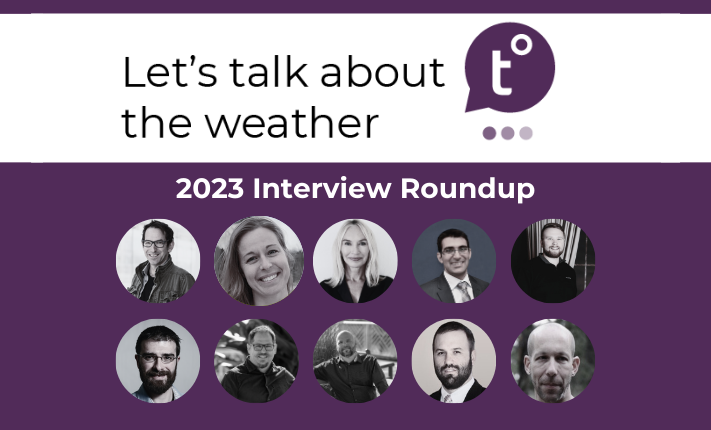Posted by Tempest ● January, 2024
Our Favorite Tempest Interviews of 2023

As we bid farewell to another remarkable year, we reflect on a series of captivating interviews that offered unique insights into the fields of science, technology, and environmental exploration. Our conversations spanned diverse topics, from the impact of climate change on insect behavior to the enduring appeal of ham radio as a global means of communication. These interviews collectively paint a picture of the innovative strides and challenges that have defined the year, providing a unique view of the diverse and ever-evolving landscape of knowledge and discovery. Join us in this reflective journey, celebrating the stories and advancements that have shaped our understanding of the world in 2023.
 DR. MATTHEW BURNS | CLEMSON UNIVERSITY
DR. MATTHEW BURNS | CLEMSON UNIVERSITY
In this exclusive interview with Dr. Matthew Burns, Assistant Director of Agriculture and Natural Resources for the Clemson Cooperative Extension Service, we delve into the innovative initiative spearheaded by Clemson University and supported by Tempest Weather Systems – the Clemson Mesonet. Dr. Burns shares his background in livestock and agriculture, revealing how the Mesonet evolved from addressing hyperlocal weather needs to becoming a comprehensive network with Tempest Weather Stations in all 46 counties of South Carolina. The Mesonet not only plays a pivotal role in agriculture, assisting with frost protection and drought declarations but also extends its impact to education, with 4H programs integrating Tempest data into K-12 classrooms. Moreover, Dr. Burns sheds light on the growth of the Home and Garden Information Center, showcasing its role as a go-to resource for home horticulture. The interview concludes with insights into the critical importance of weather monitoring for agriculture, highlighting the Mesonet's role in providing real-time, hyperlocal data to inform crucial decisions for farmers and producers.

 CHRIS JOHNSON AND NATE FINCHER | WEATHER CHAMPS
CHRIS JOHNSON AND NATE FINCHER | WEATHER CHAMPS
In April we discovered the inception of Weather Champs, the groundbreaking weather app that merged meteorology with gaming. In our interview with founders Chris Johnson and Nate Fincher, they recounted the origins of their idea, sparked by a storm-tracking evening and a desire for a platform where weather enthusiasts could compare predictions. Despite lacking a background in meteorology, the duo recognized the potential for a unique venture that mirrored the dynamics of fantasy sports. After conducting thorough market research and securing initial funding from friends and family, Weather Champs was born. The app not only filled a gap in the market but also emerged as a comprehensive repository for weather data. The journey included exploration into crowdfunding, providing supporters with the opportunity to become official producers of the app. Looking back, Chris and Nate shared their hopes for a commercial release on both iOS and Android platforms by the end of Q2. As a delightful twist, they revealed plans to integrate Tempest API's, offering Tempest owners a new dimension of weather prediction excitement. Join us as we revisit the remarkable journey of Weather Champs and the evolution of weather forecasting into a captivating gaming experience.
In response to the escalating challenges posed by climate change, Ann Marie Gardner embarked on a mission to transform environmental data into a captivating and accessible resource for homeowners. The platform, comprising a website, newsletter, and climate assessment tool, stands as a vital guide for individuals navigating a rapidly changing landscape. Gardner's inspiration came from a 2019 New York Times article featuring Harvard professor Jesse Keenan, advocating for climate-friendly living in Duluth and Buffalo. Habitable's innovative approach allows users to assess their home's risk factors, from floods to ticks, empowering families and individuals in making informed decisions about their living spaces. Beyond climate reports, the platform offers expert guidance on fortifying homes against extreme weather impacts, promoting individual readiness through proactive measures. The curated newsletter complements the rich content, featuring climate research, real estate insights, and captivating stories about homes, providing an entertaining yet informative experience. As climate change continues to reshape lives, Habitable emerges as a steadfast companion, simplifying the complexities of climate data and guiding homeowners toward resilient, adaptable, and sustainable living spaces.
 DR. MEHDI NEMATI | UNIVERSITY OF CALIFORNIA, RIVERSIDE
DR. MEHDI NEMATI | UNIVERSITY OF CALIFORNIA, RIVERSIDE
In August Dr. Mehdi Nemati, lead author of a recent UC Riverside study, delved into the intricacies of water conservation in California, particularly focusing on the behavioral shifts observed during and after droughts. Highlighting the decision-making entities behind conservation mandates and rebound effects, Dr. Nemati draws attention to the study's dataset from a Northern California water utility, emphasizing hourly data points and behavioral changes. The findings reveal a nuanced impact, showcasing not only a rebound effect in water usage post-mandate but also a positive shift in consumption hours due to educational efforts. Dr. Nemati discusses the implications for water utilities, emphasizing the challenges of future drought responses and the role of efficiency gains, shedding light on the socioeconomic factors influencing water conservation practices among residents.
In the realm of weather analysis and social media, Ryan Hall, known as Ryan Hall, Y'all on YouTube, has carved a niche with his entertaining and informative content, amassing millions of subscribers across platforms like YouTube and TikTok. We sat down with Ryan in July of 2023 to talk about his online following and expertise as an online meteorological expert and storm chaser. Starting his weather journey at the age of 14, Ryan shared his passion for meteorology and recounts the organic growth of his now massive multimedia weather empire. Offering advice to aspiring meteorologists, he emphasizes starting with genuine love for weather, sharing insights on pursuing a meteorology degree. While storm hunting is a cherished activity for Ryan, he surprises followers by revealing his true love for snowstorms over tornadoes. Delving into his go-to weather apps and tools, Ryan expresses his reliance on Tempest, Storm Prediction Center, and National Weather Service resources. Recalling his craziest weather experience during severe floods in southeastern Kentucky, Ryan previewed an intriguing summer for 2023 shaped by the evolving dynamics of El Niño and warmer Atlantic conditions.
 DR. JASON CORDEIRA | ATMOSPHERIC RIVER SCALE
DR. JASON CORDEIRA | ATMOSPHERIC RIVER SCALE
In a casual lunch at Chipotle, Dr. Marty Ralph and Dr. Jason Cordeira sparked the concept of an intensity scale for atmospheric rivers. This innovative scale, akin to those for hurricanes or tornadoes, measures the intensity and duration of these weather phenomena. In an insightful interview with Dr. Cordeira, we delved into the definition of atmospheric rivers and their anticipated frequency and intensity due to climate change. The interview also unveiled the origins of the Atmospheric River (AR) scale, from the initial idea drawn on a napkin to the collaboration of diverse experts shaping its development. Dr. Cordeira shed light on the scale's parameters, focusing on both benefits and hazards, and discussed its global applications. While the National Weather Service has yet to widely adopt the AR scale, ongoing research at the Center for Western Weather and Water Extremes aims to refine forecasting, emphasizing actionable predictions. The interview concluded with a glimpse into future endeavors, including research partnerships and applications of the AR scale in climate resiliency efforts, exemplified by forecast-informed reservoir operations.
 DR. KATJA FRIEDRICH | SNOWIE PROJECT, UC BOLDER
DR. KATJA FRIEDRICH | SNOWIE PROJECT, UC BOLDER
In a groundbreaking venture to validate the efficacy of cloud seeding in real-world scenarios, Professor Katja Friedrich of the University of Colorado, Boulder, played a pivotal role in the SNOWIE Project (Seeded and Natural Orographic Wintertime Clouds: The Idaho Experiment). Against the backdrop of cloud seeding skepticism since the 1940s, Friedrich's research sought to prove its success beyond the confines of a lab. The SNOWIE Project, focusing on orographic winter clouds over the Rocky Mountains, aimed to boost snowpack for efficient water storage. Friedrich, the principal investigator, recounted the project's breakthrough moment in 2017 when they observed seeded precipitation falling in zigzag lines, revolutionizing the understanding of cloud seeding. Addressing concerns about silver iodide, the seeding material, Friedrich emphasized adherence to environmental guidelines. Amid common misconceptions about cloud seeding causing drought or flooding, she highlighted its regulated nature. With climate changes affecting cloud seeding conditions, Friedrich delved into evolving strategies and the ongoing discourse on its future applications in a changing climate.
 DR. ROBERT GULNARIK | FLORIDA MUSEUM OF NATURAL HISTORY
DR. ROBERT GULNARIK | FLORIDA MUSEUM OF NATURAL HISTORY
In a quest to comprehend the rapidly changing world and its implications for biodiversity, Robert Guralnick, the Curator of Biodiversity Informatics at the Florida Museum of Natural History, spearheads research that navigates the impact of climate change on the natural world. Focused on insects, Guralnick's recent study delves into the nuanced effects of weather anomalies versus long-term climate patterns on insect behavior, leveraging massive datasets, museum specimens, and crowdsourced observations. Uncovering surprising revelations, the research highlights the substantial influence of extreme weather events on insect phenology, challenging preconceptions and offering crucial insights into the intricate web of nature's responses. Guralnick emphasizes the pivotal role of museums in providing historical insect data, elucidating how such records contribute to predicting insect behaviors and lifecycles. From the unexpected consequence of cold days extending insect activity to the broader implications for human health through altered pollination patterns and disease vectors, Guralnick sheds light on the multifaceted aspects of his team's findings. Looking ahead, the team aims to compare insect and plant responses to extreme weather, striving to mitigate risks and empower stakeholders with valuable information for decision-making in an era of environmental uncertainty.
 ERIC HOFER | HAM RADIO CONCEPTS
ERIC HOFER | HAM RADIO CONCEPTS
Delving into the rich history of ham radio, a timeless mode of global communication originating in 1901, we engaged in a conversation with Eric Hofer (KJ4YZI), a prominent figure in the ham radio community and the creator behind the popular YouTube channel hamradioconcepts. Functioning both as a hobby and an emergency service, ham radio allows individuals to communicate locally or across the globe using radios and antennas. Eric shares the essence of ham radio, emphasizing its versatility and enduring appeal, especially in times of crises when conventional communication methods falter. Reflecting on his personal journey, Eric recounts how a CB radio sparked his interest, leading him into the captivating realm of ham radio. Exploring the diverse motivations that draw people into this hobby, he highlights its role as a prepper tool, a social media precursor, and a fail-safe communication method when all else fails. Transitioning to memorable experiences, Eric discusses unforgettable contacts and the unique thrill of exchanging information via antennas. Shifting focus to the interplay of weather and ham radio, he underlines its critical role in emergency communications, citing examples like Skywarn. Eric also draws attention to the weather's omnipresence in ham radio conversations and its potential hazards, emphasizing the importance of monitoring conditions for safety. Concluding with advice for beginners, he stresses the necessity of obtaining a license and recommends affordable entry-level radios, paving the way for newcomers to immerse themselves in the fascinating world of ham radio.
 DR. JEFF COPELAND, TEMPEST NEARCAST™ TECHNOLOGY
DR. JEFF COPELAND, TEMPEST NEARCAST™ TECHNOLOGY
Early this year, we spoke with our very own Jeff Copeland, Chief Scientist at Tempest, who came to us from the Tempest Weather Lab in Fort Collins, Colorado, where his team harnesses the power of atmospheric science and data analytics to shape the future of weather forecasting. He shared insights on integrating artificial intelligence (AI) and machine learning (ML) in Tempest's Nearcast™ Technology, detailing the process of collecting and analyzing extensive weather data from various sources. Dr. Copeland clarified that AI refines numerical weather forecasts by identifying and correcting model errors rather than directly predicting weather. He emphasized AI's role in global error correction and hinted at future applications like improved rain prediction. Reflecting on his 25-year journey, Dr. Copeland highlighted a pivotal moment when he pioneered neural network AI techniques for an Australian energy utility company, paving the way for today's advancements in AI-driven weather forecasting.
As we step into the coming year, we carry with us the echoes of these conversations, a testament to the resilience of curiosity and the boundless potential for discovery in the ever-evolving landscapes of science and technology. Here's to another year of unraveling mysteries, decoding complexities, and embracing the perpetual journey of knowledge. Until then, the adventure continues.
Back to: Articles

 ANN MARIE GARDNER | HABITABLE
ANN MARIE GARDNER | HABITABLE  RYAN HALL | RYAN HALL Y'ALL
RYAN HALL | RYAN HALL Y'ALL